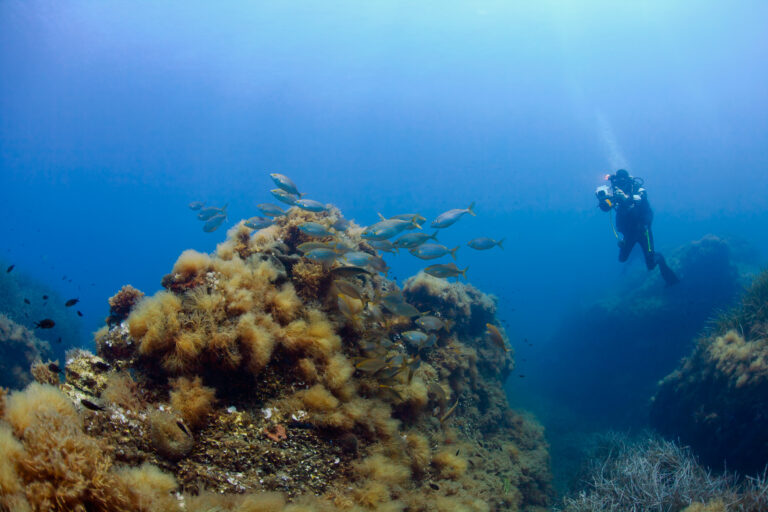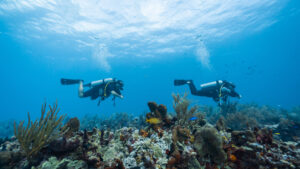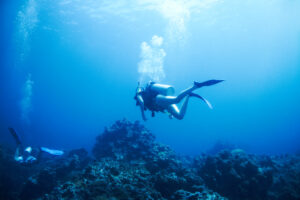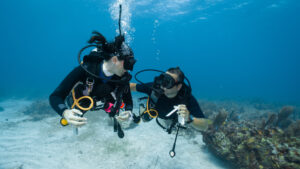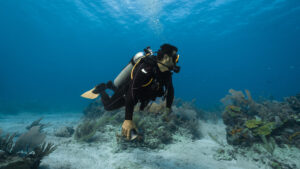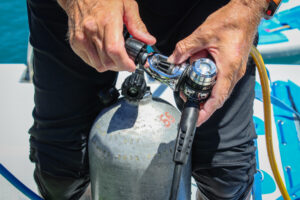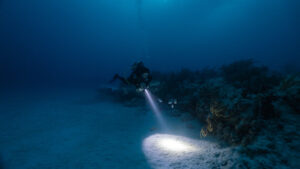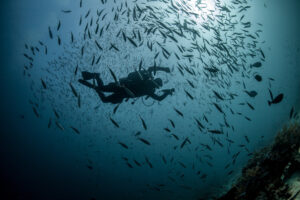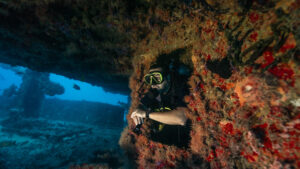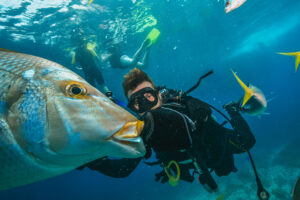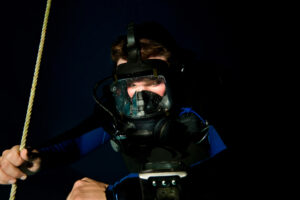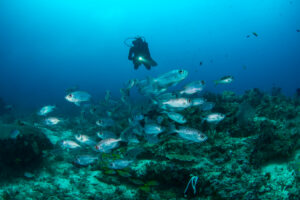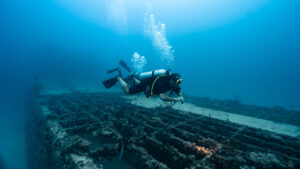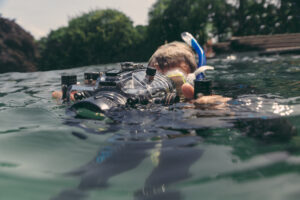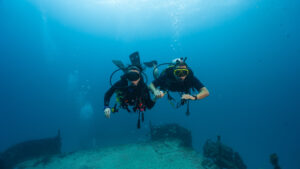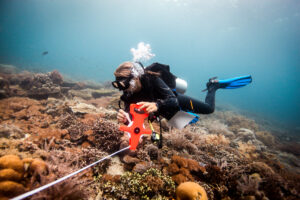What is Visibility?
Visibility in scuba diving refers to how clearly a diver can see underwater. It is measured as the distance a diver can see horizontally in the water and is a critical factor influencing the overall diving experience. High visibility allows divers to appreciate the beauty of underwater ecosystems, navigate more efficiently, and maintain safety by clearly seeing their surroundings and fellow divers. Conversely, low visibility can obscure important visual cues, making navigation more challenging and potentially increasing the risk of disorientation or accidents. Understanding the factors that affect visibility, how it is measured, and its implications for marine life and diver safety is essential for anyone involved in scuba diving.
Factors Affecting Visibility
Several factors influence underwater visibility, with both natural and human-induced elements playing significant roles. Understanding these factors helps divers anticipate and adapt to varying conditions they might encounter.
Natural factors are primary determinants of visibility. Particulate matter, such as sediment and plankton, suspended in the water column can significantly reduce visibility. Sediment can be stirred up from the seabed by currents or human activities, while plankton blooms, often seasonal, can cloud the water. Additionally, water salinity affects how light penetrates the water; in more saline waters, light can scatter more, reducing visibility. Seasonal and weather-related changes also impact visibility. For example, heavy rains can wash sediment into the ocean, and storms can stir up the seabed, both of which lead to decreased visibility. Conversely, periods of calm weather can allow particles to settle, improving visibility.
Human-induced factors also have a substantial impact. Pollution, both chemical and physical, can degrade water clarity. Chemical pollutants can change the water’s properties, affecting how light travels through it, while physical waste, such as plastics, can obscure vision. Underwater construction, like building piers or laying pipelines, can disturb sediment, reducing visibility temporarily or even for extended periods if the disturbance is ongoing or severe. Understanding these factors is crucial for divers who must plan their activities around these environmental conditions.
Measurement of Visibility
Accurately measuring visibility is essential for assessing underwater conditions. Several tools and methods are used to determine visibility, each with its strengths and limitations.
One common method is the use of a Secchi disk, a simple, low-tech tool that consists of a white or black-and-white disk lowered into the water until it is no longer visible. The depth at which the disk disappears is noted, giving a measure of water clarity. This method is straightforward and inexpensive but can be subjective and affected by factors such as the observer’s vision and lighting conditions.
More advanced tools include electronic visibility meters, which use light sensors to measure how much light is scattered and absorbed by particles in the water. These devices provide more precise and consistent readings than the Secchi disk and can operate at greater depths. However, they are more expensive and require calibration and maintenance to ensure accuracy.
Measurements can vary based on the methodology and equipment used. For example, the Secchi disk provides a general estimate of visibility but may not be accurate in waters with a high concentration of colored dissolved organic matter. Electronic meters, on the other hand, offer detailed data but might be impractical for some divers due to their cost and complexity. Despite these variations, consistent measurement practices are crucial for monitoring visibility trends and planning diving activities.
Visibility and Marine Life
Visibility profoundly affects marine life and ecosystems, influencing behaviors, habitats, and ecological dynamics. In environments with high visibility, photosynthetic organisms like algae and seagrasses thrive due to the ample light penetration. These primary producers form the basis of the food web, supporting a diverse array of marine species.
Conversely, low visibility environments present different ecological characteristics. Areas with high sediment or plankton levels may have less light penetration, affecting photosynthetic activity. However, these environments can also support rich communities of filter feeders, such as sponges and certain species of fish, which rely on suspended particles for food. The balance between visibility and marine life dynamics is complex, with each environment hosting unique adaptations and species.
Predator-prey relationships are also influenced by visibility. In clear waters, predators that rely on sight, such as sharks and large predatory fish, have an advantage. They can spot and pursue prey over greater distances. In contrast, in turbid waters, visual predators may struggle, and species that use other senses, like electroreception or smell, become more dominant. Prey species in low visibility areas often develop adaptations like enhanced sensory organs to detect predators or use camouflage to blend into their surroundings.
Understanding these relationships is crucial for marine conservation efforts. Changes in visibility due to natural events or human activities can disrupt these delicate balances, leading to shifts in species composition and ecosystem health. Protecting areas with unique visibility characteristics helps preserve the biodiversity and ecological functions they support.
Visibility and Diving Safety
Visibility is a critical factor in ensuring diving safety. Poor visibility can significantly impact a diver’s orientation, spatial awareness, and ability to navigate underwater, increasing the risk of accidents or becoming lost.
In conditions of reduced visibility, divers may struggle to see their surroundings clearly, making it challenging to maintain a sense of direction. This can lead to disorientation, where divers lose track of their position relative to their entry point or exit point. Reduced visibility also makes it harder to spot potential hazards, such as sharp objects, entangling debris, or dangerous marine life.
Safety protocols are essential when diving in low visibility. Divers are trained to use specific techniques to enhance safety, such as maintaining close contact with a buddy and using tactile communication signals. The buddy system is particularly important in low visibility, as divers can quickly lose sight of each other. Staying close ensures that if one diver encounters a problem, the other can provide immediate assistance.
Navigation tools become crucial in low visibility conditions. Compasses, dive computers, and underwater maps help divers maintain their orientation and find their way back to their starting point. Divers may also use physical markers, such as lines or buoys, to create a reference point in environments where natural landmarks are hard to see.
Understanding the impact of visibility on safety helps divers prepare adequately for their underwater adventures. Proper training, equipment, and planning can mitigate the risks associated with low visibility, ensuring a safer and more enjoyable experience.
Improving and Adapting to Visibility Conditions
Divers have several techniques and equipment options to improve and adapt to varying visibility conditions, ensuring they can continue to enjoy underwater activities safely and effectively.
One common method to enhance visibility is the use of dive lights. These lights, designed specifically for underwater use, can penetrate the darkness and murkiness of the water, illuminating the diver’s path and surroundings. Dive lights come in various sizes and intensities, allowing divers to choose the appropriate tool for their specific conditions. High-intensity lights are beneficial in very low visibility environments, while smaller lights can be sufficient in moderately clear waters.
Special masks and goggles can also aid in visibility. Some masks are designed with wider lenses and better sealing to prevent fogging, providing a clearer view. Anti-fog solutions and regular cleaning of masks are simple yet effective practices to maintain optimal visibility. Certain masks also come with prescription lenses for divers who require vision correction, ensuring they can see as clearly underwater as they do on land.
Training and skills are vital for adapting to visibility changes. Divers are taught specific techniques for low visibility conditions, such as maintaining a slow and steady pace to avoid stirring up sediment, using hand signals for communication, and relying on tactile feedback from their surroundings. Proper training ensures divers are equipped with the knowledge and skills to handle different visibility scenarios safely.
In addition to personal equipment and skills, understanding the environment and planning dives according to visibility conditions is essential. Checking weather forecasts, tidal charts, and local diving reports can provide valuable information about expected visibility. Planning dives during times of optimal visibility, such as slack tide, when water movement is minimal, can significantly improve the diving experience.
Visibility in Popular Diving Destinations
Visibility varies greatly across popular diving destinations, with some locations renowned for their crystal-clear waters, while others are known for more challenging conditions. Understanding these variations helps divers choose the best spots for their preferences and experience levels.
The Caribbean is famous for its exceptional visibility, often exceeding 30 meters (98.4 feet) in many locations. Sites like the Cayman Islands and the Bahamas offer divers the chance to explore vibrant coral reefs, abundant marine life, and dramatic underwater landscapes with unparalleled clarity. The clear waters are attributed to the region’s calm seas, minimal sediment disturbance, and abundant sunlight, making it a favorite destination for both novice and experienced divers.
In contrast, Northern European waters present more challenging visibility conditions. Locations like the North Sea and parts of the Baltic Sea often have visibility limited to a few meters due to high levels of sediment, plankton blooms, and colder water temperatures. These conditions, while less ideal for recreational diving, offer unique opportunities for those interested in cold-water marine life and shipwreck exploration. Divers in these regions must be well-prepared and trained to handle low visibility and colder temperatures.
Diving in the Indo-Pacific region, including places like Indonesia and the Philippines, offers a mix of visibility conditions. Some areas boast clear waters with visibility similar to the Caribbean, especially around oceanic islands and protected marine parks. However, coastal areas and regions with significant river runoff can experience reduced visibility. The rich biodiversity of these waters makes them a top choice for divers, with the chance to see a wide range of marine species, including many that are endemic to the region.
Understanding the visibility characteristics of different diving destinations helps divers plan their trips according to their interests and skill levels. Whether seeking the clear, warm waters of tropical paradises or the adventurous conditions of colder, murkier seas, divers can find suitable locations that match their preferences.
Key Takeaways
Visibility is a fundamental aspect of scuba diving, influencing everything from the aesthetic enjoyment of marine environments to safety and navigation. Factors affecting visibility include natural elements like sediment and plankton, as well as human-induced influences such as pollution and construction. Accurate measurement of visibility using tools like the Secchi disk and electronic meters is crucial for assessing underwater conditions. Visibility also impacts marine life,
with different environments supporting diverse ecosystems. Diver safety relies heavily on visibility, necessitating specific training and equipment to navigate low-visibility conditions effectively. Popular diving destinations vary widely in visibility, offering unique experiences tailored to different preferences and skill levels. Understanding and adapting to visibility conditions are essential for a safe and enjoyable diving experience.

